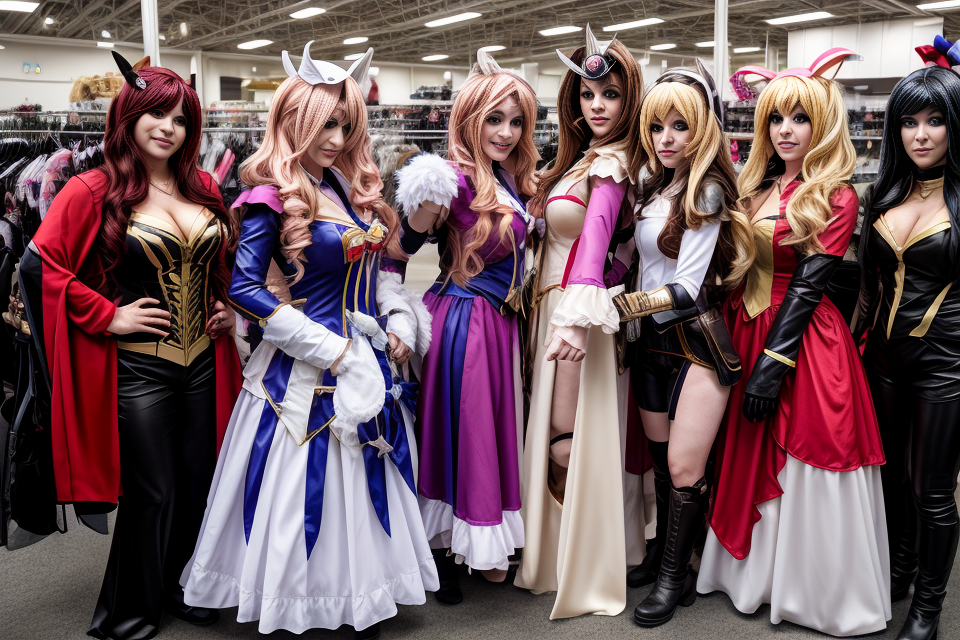Cosplay, short for “costume play,” is a popular hobby that involves dressing up as characters from movies, TV shows, video games, and other forms of media. But just how much do people spend on costumes? In this article, we’ll take a deep dive into the expenses of cosplayers and explore the many factors that can influence the cost of a cosplay outfit. From materials to accessories, we’ll examine the different elements that can add up to create a stunning and authentic cosplay look. So, grab your sewing machine and join us as we delve into the world of cosplay expenses!
How Much Do People Spend on Costumes?
The Average Cost of a Cosplay Costume
The cost of a cosplay costume can vary widely depending on a number of factors, including the complexity of the design, the materials used, and the level of detail involved. On average, a cosplay costume can cost anywhere from $50 to several thousand dollars.
One of the most significant factors that can affect the cost of a cosplay costume is the level of detail involved. A costume that requires intricate craftsmanship, specialized materials, or extensive modifications to fit the wearer’s body type can be significantly more expensive than a simpler design.
The materials used in a cosplay costume can also impact the overall cost. High-end materials like leather, fur, or real metal can significantly increase the price of a costume, while more affordable options like synthetic fabrics or foam can help keep costs down.
Additionally, the cost of a cosplay costume can be influenced by the size and complexity of the costume. A full-body armor suit, for example, can cost several thousand dollars to produce, while a simple dress or pair of pants may only cost a few hundred dollars.
Overall, the average cost of a cosplay costume can vary widely depending on the individual design and the materials used. However, it is important to remember that cosplay is a hobby, and the cost of a costume should never be a barrier to participation. With careful planning and budgeting, cosplayers can create amazing costumes without breaking the bank.
The Impact of Cosplay on Personal Finances
Cosplay can be an expensive hobby, and the costs associated with it can have a significant impact on the personal finances of cosplayers. From buying or making costumes to purchasing accessories and props, cosplayers often have to make difficult decisions when it comes to allocating their funds.
Balancing Cosplay Expenses with Other Expenses
Many cosplayers have to balance their cosplay expenses with other financial obligations, such as rent, bills, and everyday expenses. This can be challenging, especially for those who are on a tight budget or have limited income. As a result, cosplayers may have to prioritize their spending, choosing to invest in a few high-quality costumes rather than purchasing multiple lower-quality ones.
The Role of Crowdfunding in Cosplay Financing
Crowdfunding has become a popular way for cosplayers to finance their hobby. Websites like Kickstarter and Indiegogo allow cosplayers to create campaigns to raise funds for their costumes and accessories. While crowdfunding can be a useful tool for cosplayers, it can also come with its own set of challenges. For example, cosplayers may have to spend a significant amount of time promoting their campaigns, and there is no guarantee that the campaign will be successful. Additionally, crowdfunding can be a risky option for cosplayers, as they may not receive all of the funds they have pledged if the campaign does not reach its target goal.
Cosplay Expenses: From Materials to Accessories
The Cost of Cosplay Materials
Cosplay materials are one of the most significant expenses that cosplayers face. These materials are used to create the costumes, accessories, and props that are central to cosplay. In this section, we will explore the different types of materials used in cosplay costumes and provide tips for saving money on cosplay materials.
Types of Materials Used in Cosplay Costumes
Cosplay costumes can be made from a wide range of materials, including:
- Fabric: This is the most common material used in cosplay costumes. Common types of fabric used in cosplay include cotton, polyester, satin, and spandex.
- Wire: Wire is often used to create structural elements of the costume, such as armor or structured pieces.
- Foam: Foam is commonly used to create armor, helmets, and other prop pieces.
- Paint: Paint is used to add detail and color to the costume and props.
- Thermoplastics: Thermoplastics, such as EVA and PVC, are used to create prop pieces and accessories.
Tips for Saving Money on Cosplay Materials
Cosplay can be an expensive hobby, but there are ways to save money on materials. Here are some tips for cutting costs:
- Shop at thrift stores: Thrift stores are a great place to find inexpensive fabric, wig caps, and other materials.
- Use everyday items: Everyday items, such as cardboard boxes and plastic containers, can be repurposed to create props and accessories.
- Buy in bulk: If you are planning to make multiple costumes or props, consider buying materials in bulk. This can save you money in the long run.
- Look for sales: Keep an eye out for sales and discounts on materials. Many craft stores offer sales and discounts on materials regularly.
- DIY: Consider making your own materials or accessories. For example, you can make your own wire armor or paint your own props.
By being mindful of these tips, cosplayers can save money on materials and still create amazing costumes and props.
The Cost of Cosplay Accessories
- Importance of Accessories in Cosplay
In cosplay, accessories play a crucial role in bringing a character to life. They add depth and dimension to a costume, helping to complete the transformation from a cosplayer into their chosen character. From wigs and contact lenses to props and jewelry, accessories can make or break a cosplay, and they often come with a hefty price tag.
- Popular Cosplay Accessories and Their Costs
Some of the most popular cosplay accessories and their costs include:
- Wigs: Depending on the quality and length of the wig, prices can range from $50 to $300 or more. High-end wigs made from real hair can cost even more.
- Contact lenses: Cosplay contact lenses can range from $20 to $50 per pair, with more elaborate designs and colors costing more.
- Props: Props can range from simple items like swords or staffs to more complex items like vehicles or furniture. The cost of props can vary widely depending on the item and its level of detail.
- Jewelry: Jewelry can add the perfect finishing touch to a cosplay, but it can also be one of the most expensive accessories. Costs can range from $20 to $200 or more, depending on the item and its quality.
- Shoes: Depending on the style and level of detail, cosplay shoes can cost anywhere from $50 to $300 or more.
Overall, the cost of cosplay accessories can quickly add up, making it an important factor for cosplayers to consider when planning their next cosplay.
Cosplay Events: Expenses Beyond the Costume
The Cost of Attending Cosplay Events
- Ticket Prices for Cosplay Events
- Cosplay events often require tickets, and the prices can vary greatly depending on the event, location, and the level of access granted. For example, a general admission ticket to a large-scale convention like Comic-Con International in San Diego can cost around $50, while a VIP pass with exclusive access to panels and events can cost upwards of $1,000.
- In addition to ticket prices, cosplayers may also need to purchase additional tickets for friends or family members who wish to attend the event with them.
- Transportation and Accommodation Costs for Cosplay Events
- Depending on the location of the cosplay event, cosplayers may need to factor in transportation costs such as flights, trains, or buses, as well as accommodation costs for hotels or other lodging options.
- For example, if a cosplayer lives in a different city or country from the event, they may need to budget for round-trip flights, hotel stays, and transportation to and from the event venue.
- The cost of transportation and accommodation can vary greatly depending on the location of the event and the time of year, with peak travel seasons and popular events often resulting in higher prices.
- Cosplayers may also need to budget for additional expenses such as food and entertainment while attending the event, which can add to the overall cost of attending a cosplay event.
The Cost of Competing in Cosplay Competitions
Cosplay competitions are a significant aspect of cosplay culture, where cosplayers showcase their craftsmanship and dedication to their chosen characters. While the cost of the cosplay itself is a significant expense, competing in cosplay competitions comes with additional expenses that cosplayers need to consider. In this section, we will explore the costs associated with competing in cosplay competitions.
Registration Fees for Cosplay Competitions
Cosplay competitions often require a registration fee to cover the costs of organizing and running the event. These fees can vary depending on the size and scope of the competition, with larger events typically having higher fees. Cosplayers should budget for these fees when deciding to compete in a cosplay competition.
Preparation Costs for Cosplay Competitions
In addition to the registration fee, cosplayers competing in cosplay competitions must also consider the costs associated with preparing for the competition. This can include costs for materials, accessories, and any additional props or effects needed to bring the cosplay to life. Cosplayers may also need to budget for transportation and accommodation costs if the competition is located far from their hometown.
Some cosplayers may also choose to hire professionals, such as makeup artists or photographers, to help them prepare for the competition. These costs can add up quickly and should be taken into consideration when budgeting for a cosplay competition.
Travel and Accommodation Expenses
For cosplayers who live far from the competition venue, travel and accommodation expenses can be a significant expense. Cosplayers may need to budget for transportation costs, such as flights or train tickets, as well as accommodation costs for the duration of the competition.
In addition, cosplayers may need to budget for additional expenses such as meals and incidentals while they are at the competition. These costs can add up quickly and should be taken into consideration when budgeting for a cosplay competition.
Entry Fees for Side Events
Some cosplay competitions may offer side events, such as workshops or panels, that cosplayers can participate in. While these events can be a great opportunity to learn and network, they often come with additional entry fees. Cosplayers should budget for these fees if they plan to participate in any side events.
Overall, competing in cosplay competitions can be a rewarding experience, but it comes with additional expenses that cosplayers need to consider. By budgeting for registration fees, preparation costs, travel and accommodation expenses, and any additional side events, cosplayers can ensure that they have a successful and enjoyable experience at the competition.
Cosplay as a Business: Investing in Cosplay Costumes
Starting a Cosplay Business
- Investment Required to Start a Cosplay Business
- The cost of starting a cosplay business can vary depending on the scale of the operation and the level of experience of the cosplayer. Some of the initial investments required to start a cosplay business include the cost of materials, equipment, and tools needed to create costumes. This can range from basic sewing supplies such as fabric, thread, and needles to more specialized equipment like wigs, props, and cosplay weapons.
- The cost of starting a cosplay business can also include the cost of marketing and advertising to promote the business and attract clients. This can include website design and hosting, social media management, and participation in cosplay events and conventions.
- Opportunities and Challenges of Starting a Cosplay Business
- Starting a cosplay business can provide opportunities for cosplayers to monetize their hobby and potentially turn it into a full-time career. It can also provide opportunities to network with other cosplayers and industry professionals, as well as gain recognition and exposure within the cosplay community.
- However, starting a cosplay business also comes with challenges and risks. The cosplay industry is highly competitive, and it can be difficult to stand out among other cosplayers and businesses. Additionally, there is a risk of financial loss if the business does not generate enough revenue to cover expenses and make a profit. It is important for cosplayers to carefully consider the investment required to start a cosplay business and weigh the potential benefits and risks before deciding to pursue this path.
Investing in High-Quality Cosplay Costumes
Benefits of Investing in High-Quality Cosplay Costumes
Investing in high-quality cosplay costumes can be beneficial for cosplayers who are serious about their craft. High-quality costumes are made with better materials, are more durable, and can withstand multiple wearings. This means that cosplayers can get more use out of their costumes, making the investment worthwhile. Additionally, high-quality costumes often look more authentic and can help cosplayers achieve a more accurate representation of their chosen character.
Factors to Consider When Investing in High-Quality Cosplay Costumes
When investing in high-quality cosplay costumes, cosplayers should consider several factors. First, they should consider the cost of the costume. High-quality costumes can be expensive, but they are often worth the investment. Cosplayers should also consider the materials used to make the costume. Costumes made with better materials will last longer and will be more comfortable to wear. Additionally, cosplayers should consider the level of detail in the costume. High-quality costumes are often highly detailed, which can help them look more authentic. Finally, cosplayers should consider the reputation of the costume maker. Costumes made by reputable makers are often of higher quality and will last longer.
Cosplay and Budgeting
Setting a Cosplay Budget
Setting a cosplay budget is an essential step for any cosplayer looking to manage their expenses and ensure that they can afford the costumes and props they need for their chosen characters. To help you get started, here are some factors to consider when setting your cosplay budget:
- Cosplay Costume Costs: Depending on the complexity of the costume, the materials used, and the level of detail required, the cost of a cosplay outfit can vary significantly. For example, a simple t-shirt and shorts cosplay might cost as little as $20, while a detailed and intricate movie or video game character costume could cost several hundred dollars or more.
- Props and Accessories: In addition to the costume, cosplayers may also need to budget for props and accessories that help bring their character to life. This could include things like weapons, masks, gloves, belts, and other items that are specific to the character’s design. The cost of these items can vary widely depending on their complexity and the materials used.
- Transportation and Accommodation: If you plan to attend cosplay events or conventions, you’ll need to budget for transportation and accommodation costs. This could include the cost of a plane ticket, train or bus fare, hotel room, or other expenses related to attending the event.
- Food and Beverage: While at an event, you’ll also need to budget for food and beverage expenses. This could include the cost of meals at the convention center or nearby restaurants, as well as any snacks or drinks you may need throughout the day.
- Miscellaneous Expenses: Finally, you’ll need to budget for any miscellaneous expenses that may arise. This could include things like parking fees, taxis or rideshare services, or other small expenses that add up over time.
By considering these factors and setting a realistic cosplay budget, you can ensure that you have enough money to cover all of your expenses and create the perfect cosplay costume without breaking the bank.
Managing Cosplay Expenses
Managing cosplay expenses is a crucial aspect of cosplaying, especially for those who are on a tight budget. With the right strategies, cosplayers can effectively manage their expenses and enjoy their hobby without breaking the bank.
Strategies for Managing Cosplay Expenses
One effective strategy for managing cosplay expenses is to prioritize expenses based on the importance of the costume or prop. For example, a costume for a character that is central to a cosplayer’s identity may be considered more important than a less frequently used costume. By prioritizing expenses, cosplayers can ensure that they are allocating their resources effectively and avoid overspending on less important costumes.
Another strategy for managing cosplay expenses is to shop smart. This can include buying materials on sale, shopping at discount stores, or purchasing second-hand costumes. Additionally, cosplayers can save money by making their own costumes and props, which can be a cost-effective alternative to buying pre-made items.
The Role of Prioritization in Cosplay Financing
Prioritization plays a crucial role in cosplay financing, as it allows cosplayers to allocate their resources effectively. By prioritizing expenses, cosplayers can ensure that they are spending their money on the costumes and props that are most important to them, while avoiding overspending on less important items.
Additionally, prioritization can help cosplayers make difficult decisions about which costumes to make or buy. For example, if a cosplayer has a limited budget, they may need to prioritize buying a costume for their favorite character over a costume for a less important character.
Overall, managing cosplay expenses is a critical aspect of cosplaying, and effective strategies can help cosplayers enjoy their hobby without breaking the bank. By prioritizing expenses and shopping smart, cosplayers can make the most of their resources and create amazing costumes and props.
Cosplay and Value for Money
Maximizing Value for Money in Cosplay
As cosplay can be an expensive hobby, it’s important for cosplayers to make the most out of their budget. Here are some tips on how to maximize value for money in cosplay:
Tips for Getting the Most Out of Your Cosplay Budget
- Prioritize your spending: Determine which elements of your cosplay are most important to you and allocate your budget accordingly. For example, if you value accuracy, you may want to spend more on high-quality materials for your costume.
- Plan ahead: Give yourself plenty of time to research and gather materials for your cosplay. This will help you avoid last-minute rush orders that can drive up costs.
- Consider alternative options: Don’t be afraid to think outside the box when it comes to sourcing materials. For example, you may be able to find a similar fabric at a lower price point, or repurpose an item you already own.
- Seek advice: Don’t be afraid to ask for advice from more experienced cosplayers. They may have tips on how to save money without sacrificing quality.
Finding Affordable Cosplay Options That Provide Good Value
- Buy in bulk: Consider purchasing materials in bulk if you plan on making multiple costumes. This can save you money in the long run.
- Shop around: Don’t be afraid to compare prices from different vendors. You may be able to find a better deal elsewhere.
- Consider DIY options: For simpler cosplays, consider making your own costume. This can save you money and allow you to customize your costume to your liking.
- Attend conventions: Attend local conventions and cosplay events to connect with other cosplayers and vendors. You may be able to find discounts or deals on materials and accessories.
The Impact of Quality on Cosplay Value for Money
When it comes to cosplay, the quality of the costume can have a significant impact on its value for money. The relationship between quality and value for money in cosplay is complex and multifaceted.
The Relationship Between Quality and Value for Money in Cosplay
In general, the higher the quality of a cosplay costume, the higher its value for money. A well-made costume will not only look better, but it will also be more durable and comfortable to wear. Additionally, a high-quality costume will often be more accurate to the original source material, which can enhance the overall cosplay experience.
However, the relationship between quality and value for money is not always straightforward. The cost of a cosplay costume can vary widely depending on factors such as the materials used, the level of detail, and the complexity of the design. For example, a simple costume made from inexpensive materials may be less expensive upfront, but it may not be as durable or long-lasting as a more expensive costume made from higher-quality materials.
Balancing Quality and Affordability in Cosplay
Cosplayers often face the challenge of balancing the desire for a high-quality costume with the need to stay within a budget. This can be particularly challenging for cosplayers who are on a tight budget or who are creating multiple costumes for a convention or event.
One way to balance quality and affordability is to prioritize certain elements of the costume. For example, a cosplayer may choose to invest in high-quality materials for the most visible parts of the costume, such as the mask or the centerpiece of the outfit, while using more affordable materials for less visible areas, such as the lining or the underside of the costume.
Another way to balance quality and affordability is to focus on cost-effective alternatives that still deliver a high-quality result. For example, a cosplayer may choose to make the costume themselves, which can be a more affordable option than purchasing a pre-made costume. However, it also requires more time and effort, which may not be feasible for all cosplayers.
Ultimately, the impact of quality on cosplay value for money will vary depending on the individual cosplayer’s priorities and budget. Cosplayers must carefully consider their options and make choices that balance their desire for a high-quality costume with their need to stay within their budget.
FAQs
1. How much do people spend on costumes?
Costs can vary greatly depending on the complexity and materials of the costume. Simple costumes made from materials like cloth and foam can cost anywhere from $50 to $200, while more intricate costumes made from materials like latex, rubber, and Worbla can cost several thousand dollars. The cost of a costume can also be influenced by the level of detail and the amount of work required to create it.
2. What factors can affect the cost of a costume?
The cost of a costume can be influenced by a variety of factors, including the materials used, the level of detail, the size of the costume, and the skill level of the person creating it. Additionally, the cost of a costume can also be affected by the availability of the materials and the cost of shipping and handling.
3. Is it cheaper to make a costume or buy one?
Making a costume can be cheaper than buying one, but it also depends on the complexity of the costume and the skills of the person making it. Making a costume can be more cost-effective if you have the skills and tools to create it yourself, but buying a costume can be more convenient and may be a better option if you are short on time.
4. Can I save money on a costume by using second-hand materials?
Yes, using second-hand materials can be a great way to save money on a costume. Many cosplayers buy materials from second-hand stores or online auctions and repurpose them for their costumes. However, it’s important to make sure that the materials are in good condition and will be suitable for the costume.
5. How can I make sure I have enough money for a costume?
To make sure you have enough money for a costume, it’s important to budget and plan ahead. Consider the cost of the materials, the cost of any tools or equipment you may need, and the cost of shipping and handling. You may also want to consider selling or trading items you no longer need to raise funds for your costume.









